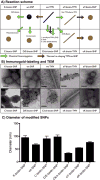Tobacco mosaic virus-based protein nanoparticles and nanorods for chemotherapy delivery targeting breast cancer
- PMID: 26941034
- PMCID: PMC5207211
- DOI: 10.1016/j.jconrel.2016.02.045
Tobacco mosaic virus-based protein nanoparticles and nanorods for chemotherapy delivery targeting breast cancer
Abstract
Drug delivery systems are required for drug targeting to avoid adverse effects associated with chemotherapy treatment regimes. Our approach is focused on the study and development of plant virus-based materials as drug delivery systems; specifically, this work focuses on the tobacco mosaic virus (TMV). Native TMV forms a hollow, high aspect-ratio nanotube measuring 300×18nm with a 4nm-wide central channel. Heat-transformation can be applied to TMV yielding spherical nanoparticles (SNPs) measuring ~50nm in size. While bioconjugate chemistries have been established to modify the TMV rod, such methods have not yet been described for the SNP platform. In this work, we probed the reactivity of SNPs toward bioconjugate reactions targeting lysine, glutamine/aspartic acid, and cysteine residues. We demonstrate functionalization of SNPs using these chemistries yielding efficient payload conjugation. In addition to covalent labeling techniques, we developed encapsulation techniques, where the cargo is loaded into the SNP during heat-transition from rod-to-sphere. Finally, we developed TMV and SNP formulations loaded with the chemotherapeutic doxorubicin, and we demonstrate the application of TMV rods and spheres for chemotherapy delivery targeting breast cancer.
Keywords: Breast cancer; Drug delivery; Nanoparticles; Nanorods; Tobacco mosaic virus.
Copyright © 2016 Elsevier B.V. All rights reserved.
Figures





References
-
- Von Hoff DD, Layard MW, Basa P, Davis HL, Jr, Von Hoff AL, Rozencweig M, et al. Risk factors for doxorubicin-induced congestive heart failure. Ann Intern Med. 1979;91:710–717. - PubMed
-
- Musci M, Loebe M, Grauhan O, Weng Y, Hummel M, Lange P, et al. Heart transplantation for doxorubicin-induced congestive heart failure in children and adolescents. Transplant Proc. 1997;29:578–579. - PubMed
-
- Lieverse RJ, Ossenkoppele GJ. Prevention of doxorubicin-induced congestive heart failure by continuous intravenous infusion in multiple myeloma; a case report and review of the literature. Neth J Med. 1991;38:33–34. - PubMed
-
- Ibrahim NK, Hortobagyi GN, Ewer M, Ali MK, Asmar L, Theriault RL, et al. Doxorubicin-induced congestive heart failure in elderly patients with metastatic breast cancer, with long-term follow-up: the M.D. Anderson experience. Cancer Chemother Pharmacol. 1999;43:471–478. - PubMed
-
- Haq MM, Legha SS, Choksi J, Hortobagyi GN, Benjamin RS, Ewer M, et al. Doxorubicin-induced congestive heart failure in adults. Cancer. 1985;56:1361–1365. - PubMed
Publication types
MeSH terms
Substances
Grants and funding
LinkOut - more resources
Full Text Sources
Other Literature Sources
Medical

